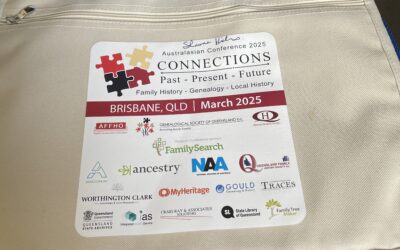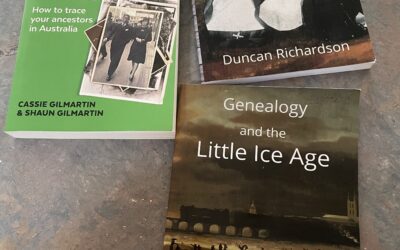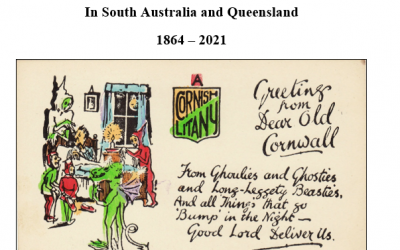This blog challenge is to stimulate my own genealogy blogging efforts in 2014 by focussing on a different kind of genealogical record each week. I wanted a challenge that reflected my own archival background as well as my own genealogy interests and there are probably lots of other records that I could have included. The challenge has an Australian focus but most of these records will be found just about anywhere in the genealogy world.
The 52 different types of genealogical records I finally decided on are listed in no particular order (each week will be a random surprise). Originally I planned to do this over 52 weeks but I now realise that I have to factor in travel and illness so it will continue a little bit over a year. Anyone is welcome to do all or part of this blogging challenge. Let me know if you are participating and I will put a link to your post under each week’s challenge.
So far I know of five bloggers who are taking up the challenge and I have put links to their individual entries at the end of each week’s blog if they have submitted something for that week. Thanks Judy Webster, Sharn White, Cassmob, Anne and Sharon for participating and encouraging me to keep up the blog challenge myself!
Also participating in this blog challenge:
Sharon Week 8
Links to Week 1 Military Medals Week 2 Internal Migration Week 3 Probates (wills and administrations) Week 4 Memorial Cards Week 5 Family Stories Week 6 Land Records Week 7 Local Histories
Week 8 Diaries
I love diaries as they can provide so much information on a family, daily life or a trip or whatever. But sadly there are no diaries in my own immediate family records. But this does not mean that we should not look for other people’s diaries in areas that were relevant to our own ancestors.
The obvious example here is shipboard diaries – what happened to one person on a voyage probably also happened to others on board. Nicholson’s Log of Logs is a great resource to find the location of shipboard diaries and I was lucky enough to find an entry for the Mairi Bhan. This was the ship which my Irish ancestors John and Sarah Finn and their young son James came out to Queensland on in 1882. The diary was in private hands and when I contacted the family, they very generously gave me a copy of the diary.
On 29 August 1882 they all went on board the Mairi Bhan and by the next afternoon the diarist was sea sick. The next day he reported that nearly all were sick and some were wishing they had never set out. By about 3 September the diarist was feeling less ill and he started reporting sightings or porpoises, flying fish, birds and other sailing ships.
Events on board were also recorded such as fights or disputes between the passengers, concerts in the evening, the weather and in particular the wind as that impacted on how far they sailed, and routine events such as eating, washing and mending clothes.
Births and deaths on board were also noted. A number of babies and children died and were buried at sea. Two babies were also born on board, one of them on the diarist’s birthday. It just so happens that the baby born on his birthday was the son of my John and Sarah Finn! Coincidence is everywhere with family history. It also made me realise that Sarah was about 7 months pregnant when she boarded and endured all that seasickness at the beginning of the voyage, not to mention having to go up and down the ladder every day to go on deck.
As they neared the tropics, the weather became increasingly hot and most of the entries report on the weather, what the sailing was like, and as boredom set in there were more instances of disputes between some of the passengers. On 26 September 1882 the diarist got up at 4.00am to watch a beautiful comet and some of the sailors said that there had not been such a large comet since 1868. Thanks to Google and Wikipedia, I was able to identify it as the Great Comet of 1882 (it is identified by a series of numbers rather than a person’s name). I hope my ancestors also managed to see it and perhaps this is a family trait as I have always been fascinated by the night time sky and have often got up to watch for comets and shooting stars.
As they continued sailing south, the weather became colder and they started to see whales, sharks, albatrosses, and other birds which the diarist said looked beautiful flying around the ship. The rougher seas meant that people were again sea sick but the strong winds also meant that they made good progress. Finally, on the morning of 26 November they saw land in the distance and by the afternoon they could easily see Moreton Lighthouse. On 28 November they boarded the steamer Kate to be taken into Brisbane and it was a ‘grand parting when we left the ship. They fired three rounds out of the cannon and there was plenty of cheering’.
They were 91 days at sea and the diarist made an entry for every day so I have a day by day account of what the voyage was like for my own great great grandparents. It would have been slightly different for them, especially after the baby was born, but they would still have seen and experienced the same weather and day to day sailing highs and lows.
There are all kinds of diaries, some more detailed than others. I also try to find personal accounts of areas where my families lived and recently I have started to look for military unit histories and diaries to supplement what I have found in army dossiers. If you have never thought of exploring these types of records before, why not try and find a shipboard diary for an ancestor’s voyage. You may be pleasantly surprised.





Thanks Shauna,
You may be interested on this Rootsweb link which expands on Log of Logs for people who cannot readily access a physical copy http://freepages.genealogy.rootsweb.ancestry.com/~nzbound/logs.htm